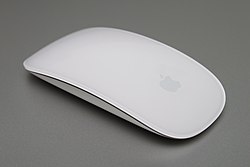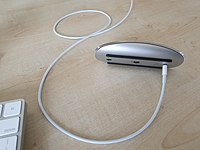Magic Mouse
 White and silver Magic Mouse | |
| Manufacturer | Apple Inc. Foxconn (contract manufacturer) |
|---|---|
| Type | Multi-touch clear acrylic surface with laser tracking mouse |
| Release date |
|
| Discontinued | 1st gen: October 13, 2015 |
| Connectivity |
|
| Power |
|
| Dimensions |
|
| Mass |
|
| Predecessor | Mighty Mouse |
| Related | Apple Wireless Keyboard Magic Keyboard Magic Trackpad |
| Website | Magic Mouse |
The Magic Mouse is a multi-touch wireless mouse sold by Apple Inc. and manufactured by Foxconn. The first-generation Magic Mouse was released on October 20, 2009, and introduced multi-touch functionality to a computer mouse.[1][2] Taking after the iPhone, iPod Touch, and multi-touch MacBook trackpads, the Magic Mouse allows the use of multi-touch gestures and inertia scrolling across the surface of the mouse, designed for use with macOS.
The second-generation Magic Mouse (initially marketed as Magic Mouse 2) was released on October 13, 2015, removing the use of AA batteries, instead including a lithium-ion rechargeable battery, and a Lightning port for charging and pairing, and was later made fully compatible with iPadOS.[3]
Models[edit]
1st generation[edit]
The first generation Magic Mouse was released on October 20, 2009, and introduced multi-touch functionality. It connects wirelessly to a Mac computer via Bluetooth.[4] It is powered by two AA batteries, and operates using a solid-state laser tracking sensor like the previous-generation wireless Mighty Mouse. Apple includes two non-rechargeable batteries in the box. Until 2016, Apple sold a battery charger that included two rechargeable NiMH AA batteries, designed for use with Mac peripherals.
Like its predecessor, the Mighty Mouse, the Magic Mouse includes support for secondary click.[5] The Magic Mouse has been included with most desktop Mac computers since its introduction, including the iMac, iMac Pro, and third-generation Mac Pro, as well as being available as a standalone purchase.
The Magic Mouse borrows design elements from the preceding Apple Pro Mouse, notably its seamless "zero-button" design and translucent acrylic surface for 360-degree scrolling, replacing the rubber scroll ball on the Mighty Mouse. The mouse does not support left and right-clicking simultaneously, and also removes the ability to middle click without third-party software workarounds.[6]
2nd generation[edit]
The second generation Magic Mouse was introduced in October 2015, alongside the Magic Keyboard and second-generation Magic Trackpad. A space gray color was introduced with the iMac Pro in 2017, and was later made available as a standalone purchase.[7] iPadOS 13.4 introduced mouse support to iPads for the first time, and supports all functionality of the second generation Magic Mouse.
A variety of pastel colors were introduced in 2021 to match the colors of the M1 iMac.[8] Additionally, standalone purchases include a USB-C to Lightning cable, instead of USB-A to Lightning. The space gray color was replaced by a black color with a silver aluminum finish in 2022, which was originally only available bundled with the third-generation Mac Pro.[9] All colors of the second-generation Magic Mouse have been introduced alongside matching colors for various Magic Keyboard models.[7][9]
Criticism[edit]
1st generation[edit]
Initial reception to the Magic Mouse was mixed, with reactions to its inability to trigger Exposé, Dashboard, or Spaces, as its predecessor could, or to middle click.[10] Later versions of Mac OS X include gestures to open Mission Control, which incorporates functionality from Exposé, Dashboard, and Spaces. Other issues included the mouse's unstable connection to the first and second-generation Mac Pro models, and its low-profile design being uncomfortable & unergonomic was causing palm-aches, and hand cramping for some users.[11][12]
2nd generation[edit]
The Lightning charging port is located on the bottom of the mouse, rendering it unusable while charging. This was a design choice that was widely criticized by reviewers.[13][14][15] Critics have also noted the omission of Force Touch technology, compared to the second-generation Magic Trackpad.[13][14]
Gallery[edit]
See also[edit]
References[edit]
Citations[edit]
- ^ "Magic Mouse". Apple. Archived from the original on October 6, 2015. Retrieved December 1, 2009.
- ^ Topolsky, Joshua (October 20, 2009). "Apple's Magic Mouse: One Button, Multitouch Gestures, Bluetooth, Four-Month Battery Life". Engadget. Archived from the original on October 19, 2011. Retrieved October 25, 2009.
- ^ "Review: Apple's Magic Keyboard + Magic Trackpad 2 add precision and power, lose compatibility". Archived from the original on October 21, 2015. Retrieved October 20, 2015.
- ^ "Magic Mouse 1 will not scroll on l… | Apple Developer Forums". developer.apple.com. Archived from the original on July 20, 2022. Retrieved July 29, 2022.
- ^ "Apple Magic Mouse review – the cleverest mouse yet?". techradar.com. October 27, 2009. Archived from the original on July 11, 2017. Retrieved October 8, 2014.
- ^ "How to enable "middle" click of Apple's Magic Mouse?". Ask Different. Archived from the original on September 30, 2020. Retrieved July 29, 2022.
- ^ a b "Apple Now Selling Standalone Space Gray Magic Keyboard, Magic Mouse 2, and Magic Trackpad 2". MacRumors. Archived from the original on May 19, 2022. Retrieved July 1, 2022.
- ^ "Apple Starts Selling New iMac Accessories Separately". PCMAG. Retrieved September 26, 2022.
- ^ a b SEA, Mashable (March 9, 2022). "Apple launched a new Magic Mouse, and yes, it still charges from the bottom". Mashable SEA. Archived from the original on July 1, 2022. Retrieved July 1, 2022.
- ^ Loyola, Roman (October 21, 2009). "First Look: Apple Magic Mouse". Macworld. Archived from the original on March 6, 2012. Retrieved October 25, 2009.
- ^ "Bugs & Fixes: Magic Mouse Loses Its Way". Archived from the original on March 8, 2012. Retrieved March 4, 2010.
- ^ "Has anyone experienced ergonomic problems with the Magic Mouse?". Ask Different. Archived from the original on July 29, 2022. Retrieved July 29, 2022.
- ^ a b "Review: Apple's Magic Trackpad 2 and Magic Mouse 2 open new doors for Mac". AppleInsider. Archived from the original on December 12, 2015. Retrieved December 13, 2015.
- ^ a b "Apple Magic Mouse 2 review: Mouse unable to conjure up any innovation". Macworld. Archived from the original on December 17, 2015. Retrieved December 13, 2015.
- ^ "The Sad Reality of the Magic Mouse 2". Gizmodo. Archived from the original on August 24, 2017. Retrieved December 13, 2015.
Sources[edit]
- "The Sad Reality of the Magic Mouse 2". Gizmodo. Retrieved December 9, 2015.
- "Apple forgot to revolutionize the Magic Mouse's infamous charging port". The Verge. Retrieved October 25, 2021.


